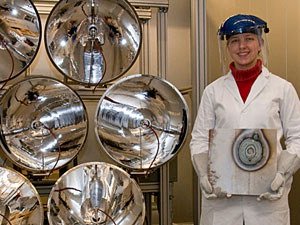From sunlight to synfuels

A new solar simulator guides research on making conventional liquid fuels from sunlight
Turning fossil fuel into energy is easy: You just burn it. And live with the carbon dioxide byproduct.
What if we could reverse the process and turn carbon dioxide back into fuel? A dream solution, but it may seem like trying to put the genie back in the bottle.
Not for University of Minnesota researchers Jane Davidson and Wojciech Lipinski, however. They and their colleagues are using concentrated light energy equal to 3,000 suns to find the most efficient way to convert carbon dioxide and water into synthetic gas, or "syngas," with solar power.
Syngas is easy to transport via pipelines and is readily converted to high-energy-density liquid hydrocarbon fuels, or "synfuels," with properties equivalent to what we derive from petroleum. An analysis by researchers from the University and Sandia National Laboratory indicates that an entire sunlight-to-synfuels process could be done with 9 percent efficiency and no input of fossil fuels.
"With 9 percent efficiency—which would be many times more efficient than using biofuels—we could replace all the petroleum consumed today in the United States with solar collectors covering 15 million acres," says Davidson, a mechanical engineering professor. "That's the size of West Virginia, and half of what we use for highways." "With 9 percent efficiency—which would be many times more efficient than using biofuels—we could replace all the petroleum in the United States with solar collectors covering 15 million acres," says Davidson, a mechanical engineering professor. "That's the size of West Virginia, and half of what we use for highways."
Favorable reactions
Davidson, Lipinski, and their colleagues are working on other approaches to conversion of concentrated sunlight. They're researching the production of syngas from biomass and aiming to generate electricity using solar heat.
Simulated sun, authentic opportunity
At the University's Solar Energy Laboratory, the process begins with a solar simulator in the form of seven mirrored, 6,500-watt lamps that concentrate the light on a 10-centimeter spot with an irradiance of 3,000 suns. (One "sun" equals 1,000 watts of solar energy falling per square meter of surface.) With this concentrated radiant energy, one can generate temperatures of more than 3,600 F in a chemical reactor. There, carbon dioxide and water are split to form carbon monoxide and hydrogen, the two components of syngas.
If the technology works in the laboratory, it could be scaled up to take advantage of the world's abundant solar energy. Deploying these technologies in the Earth's sunbelt could yield enough renewable energy to significantly exceed the world's current needs, the researchers say.
"More sun falls on Earth in one hour than is consumed globally in a year," Davidson notes. "Harvesting the sun to meet our energy needs is a challenge with a huge payoff."
Of course, it's a little more complicated than focusing concentrated sunlight into a reactor filled with carbon dioxide and water. The key to the technology rests with oxides of two metals: zinc and cerium.
"Metal oxides allow you to split water and carbon dioxide at temperatures achievable with modern solar concentrating devices," Davidson explains.
In the reactor, the metal oxides go through cycles in which they strip oxygen alternately from carbon dioxide or water--forming carbon monoxide or hydrogen, respectively--then release the oxygen as a byproduct. The syngas formed from the carbon monoxide and hydrogen can be converted into gasoline, diesel, jet fuel, methane (natural gas), or other products.
Davidson and her colleagues have produced syngas this way in their laboratory. They are now moving from laboratory demonstration to development of prototype reactors. While Davidson and Lipinski concentrate on making the next generation of reactors, University chemistry professor Andreas Stein and colleagues at Caltech and UCLA are researching new materials that could increase the efficiency and ease of operation.
If adopted, a "sunlight to synfuels" process would be an energy supply system in which the same amount of carbon dioxide that is removed from the atmosphere and locked into the fuels is released when the fuels are burned. Thus, it would be carbon neutral.
"And because synfuels can be the same as the conventional fuels, they won't require a new infrastructure," notes Lipinski.
